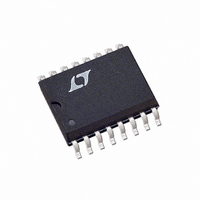LTC487CSW#TRPBF Linear Technology, LTC487CSW#TRPBF Datasheet - Page 7

LTC487CSW#TRPBF
Manufacturer Part Number
LTC487CSW#TRPBF
Description
IC DVR RS485 LOW PWR QUAD 16SOIC
Manufacturer
Linear Technology
Type
Driverr
Datasheet
1.LTC487CNPBF.pdf
(12 pages)
Specifications of LTC487CSW#TRPBF
Number Of Drivers/receivers
4/0
Protocol
RS422, RS485
Voltage - Supply
4.75 V ~ 5.25 V
Mounting Type
Surface Mount
Package / Case
16-SOIC (0.300", 7.5mm Width)
Lead Free Status / RoHS Status
Lead free / RoHS Compliant
Available stocks
Company
Part Number
Manufacturer
Quantity
Price
applicaTions inForMaTion
Losses in a transmission line are a complex combination of
DC conductor loss, AC losses (skin effect), leakage, and AC
losses in the dielectric. In good polyethylene cables such
as the Belden 9841, the conductor losses and dielectric
losses are of the same order of magnitude, leading to
relatively low overall loss (Figure 7).
When using low loss cables, Figure 8 can be used as
a guideline for choosing the maximum line length for
a given data rate. With lower quality PVC cables, the
dielectric loss factor can be 1000 times worse. PVC
twisted pairs have terrible losses at high data rates
(> 100kbs) and greatly reduce the maximum cable length.
At low data rates however, they are acceptable and much
more economical.
Figure 7. Attenuation vs Frequency for Belden 9841
Figure 8. Cable Length vs Data Rate
100
10k
1.0
0.1
10
1k
10
10k
0.1
100k
FREQUENCY (MHz)
1.0
DATA RATE (bps)
1M
10
2.5M
LTC487 TA08
LTC487 TA09
10M
100
Cable Termination
The proper termination of the cable is very important. If the
cable is not terminated with its characteristic impedance,
distorted waveforms will result. In severe cases, distorted
(false) data and nulls will occur. A quick look at the output
of the driver will tell how well the cable is terminated. It is
best to look at a driver connected to the end of the cable,
since this eliminates the possibility of getting reflections
from two directions. Simply look at the driver output
while transmitting square wave data. If the cable is termi-
nated properly, the waveform will look like a square wave
(Figure 9).
If the cable is loaded excessively (47Ω), the signal initially
sees the surge impedance of the cable and jumps to an
initial amplitude. The signal travels down the cable and is
reflected back out of phase because of the mistermination.
When the reflected signal returns to the driver, the ampli-
tude will be lowered. The width of the pedestal is equal to
twice the electrical length of the cable (about 1.5ns/foot).
If the cable is lightly loaded (470Ω), the signal reflects in
phase and increases the amplitude at the driver output.
An input frequency of 30kHz is adequate for tests out to
4000 feet of cable.
Rt = 120
Rt = 470
Rt = 47
DX
DRIVER
Figure 9. Termination Effects
PROBE HERE
Rt
RECEIVER
LTC487
LTC487 TA10
RX
487fc















